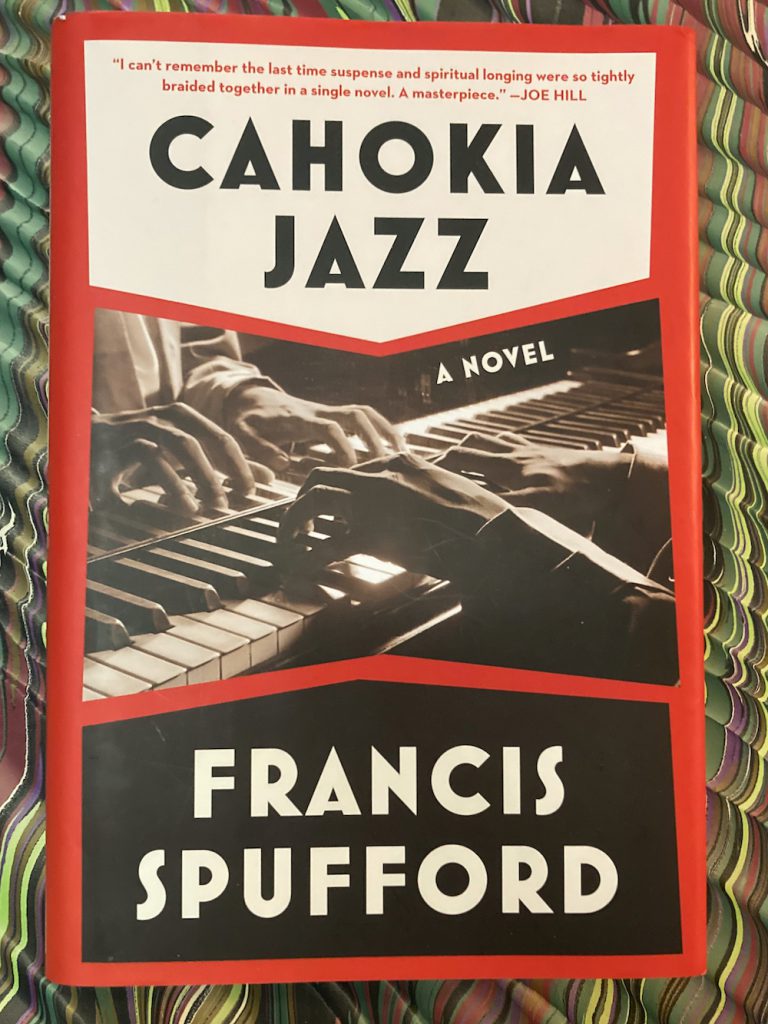
Cahokia Jazz by Francis Spufford : the Endless Bookshelf book of the year – 2024

simply messing about in books

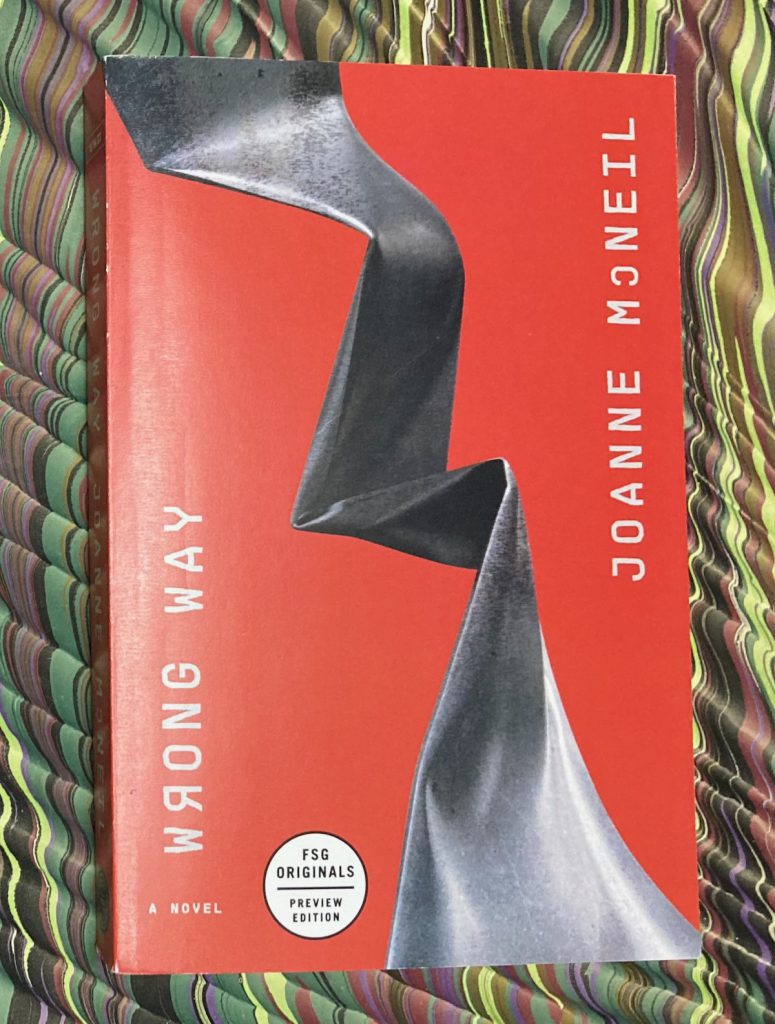
— Joanne McNeil. Wrong Way. MCD x FSG Originals, [2023].
i see things from
the under side
Don Marquis, the lives and times of archy and mehitabel
Drop everything and find a copy of Wrong Way.
This remarkable book is many things : a deep history of America through the lens of marginal employment, a social history of isolation, and an economic palimpsest of the architecture of New England mill towns. Wrong Way is the first novel by Joanne McNeil, who has a fine ear for American usages and a sneaky sense of humor evident from the first pages; her entangling memoir of technological change, Lurking. How a Person Became a User (2020) is well worth looking for. Wrong Way is a science fiction novel of the near new future, charting the life and times of Teresa Kelly, a Massachusetts woman in her late forties who swims laps the way others might jog or cycle or meditate, and who aces a virtual hand eye coordination test. “There is nothing to win,” says the recruiter, except that is never really true.
We follow Teresa in a close third-person narration that attends to small sensory details in the present and is resilient enough to sustain digressions into a litany of the jobs she has held over the years. “This could be a good job . . . ” is the voice of a pragmatic optimist and, it becomes clear, actually a pretty high bar.
The opening chapter is superb in its evocation of Teresa’s present circumstances and where she came from. Her first job as a teenager was at the jewelry counter in the showroom for an omnipresent catalogue company. “It was a good job, but those stores don’t exist now. Those jobs don’t.”
Say “Cedars” softly, without stressing the medial dental consonant.
The cognitive estrangements creep in swiftly and subtly as the shuttle bus proceeds from Boston South Station to a long-abandoned airport now repurposed as Render Falls, regional hub of the “worker first” internet company AllOver, “more than a service and experience platform”: it functions as search engine, ticketing conciergerie, payment processing, digital currency, and more. Teresa has been hired as a contract worker in the driverless car division, CR, a “transportation alternative” for top tier AllOver users. The AllOver executives — Falconer Guidry, CEO and self-made man, and Vermont Qualline, SVP of automotive engineering and daughter of a nineties country singer — have stepped from the pages of the business section of tomorrow’s newspapers, and the AllOver corporate rhetoric, ecological self-righteousness, and aspirations to a “Holistic Apex” are pitch perfect. Teresa is mature enough, and jaded enough, to be a skeptical witness, and some of the other trainee “seers” who answered the Drivers Wanted ad voice their doubts about the AllOver mission. “What kind of bottom-up change begins with people who spend fifty gs or so on an app every year?”
‘like a cockroach hiding in the kitchen walls’
The billboard in Brixboro that used to say “We Will Buy Ugly Houses” has been replaced by a picture of Plum Sasha lounging in a CR. Her teeth and blue eyes are clear and perfect. She looks carefree and young. There’s a retro eighties feel to the bubbly blue letters that read, “Luxury. Privacy. Spotless. Priceless. The CR has arrived. See it.”
Plum Sasha is an “icy-looking” teenage influencer and the advertising campaign for AllOver’s “CR driverless experience” is omnipresent. It is good advertising and pretty tough going those on the delivery side of the product. Teresa soon discovers her work as a “seer” at AllOver is not what she expected, and that things are not what they seem. On page 89, Teresa sees clearly: “It seems obvious, from the moment she sees it, but it never occurred to her earlier. Every trainee in the hangar has dark hair. There’s something else they all have in common: slim, compact bodies. It is a room of ectomorphs, each one of them about five and a half feet tall, give or take a couple of inches. Long limbs and short torsos. Bodies small enough to hide.”
At pages 110-11, things as they are become even clearer, in a “moment of weightless surrender [. . .] She is uncomfortable, still, and clings to her discomfort — once driving the CR feels natural to her is the moment she will lose control.” Coupled with the downward spiral of Teresa’s past work experiences — “The longer she worked at the museum, the more it felt like training in reverse” — this might suggest a pretty bleak book, but McNeil’s nimble prose and her eye for beauty in the mundane offer a different arc. The epigraph to this review, the refrain from “ballade of the under side” by Don Marquis, articulates my sense, from the earliest pages, that this is a novel from the economic underside of the American tech miracle. And so it was a small pleasure to see the simile “like a cockroach hiding in the kitchen walls” at page 119, part way into into the narrative drive. For drive it is: Wrong Way threads and weaves through the greater Boston area with a sureness of inborn knowledge — I have visited many times and still have no clues as to how Cambridge and Boston and the Charles River are braided together.
‘Route 128 when it’s dark outside’
We read and write on analog paper, and we read and write on electronic paper. We live in a world where the analog and the digital reciprocally permeate each other; we are hybrids, and so are our media.
Lothar Müller, Weiße Magie / White Magic, The Age of Paper (translated by Jessica Spengler)
Science fiction demands that metaphor be taken literally. Wrong Way is a science fiction novel about the hybrid nature of work in the twenty-first century. Teresa puts herself — contorts herself — into her job in a way that employers take to the bank. Capitalist systems are designed for economic returns with little heed for the human costs. “When things are good with work, all it means is, things will get worse.” The soundtrack to Wrong Way might well include “Roadrunner”, Jonathan Richman’s paean to the highway late at night, Route 128 when it’s dark outside, just before a tech boom that forms part of the geologic past of Wrong Way. The brief moments of camaraderie with fellow seers or with truck drivers are nicely done yet serve only to highlight a chronicle of isolation. I don’t want to leave the wrong impression: Wrong Way is a novel that addresses serious topics with flashes of wit and wild imagination. McNeil takes the reader to strange places. And just what happens in the last two chapters will be a matter of personal interpretation. I can’t wait to discuss it with other readers.
Drop everything and find a copy of Wrong Way. It’s an engaging and provocative work, the best book I’ve read this year.
The Endless Bookshelf book of the year 2023.
‘I can’t explain it and I don’t try’
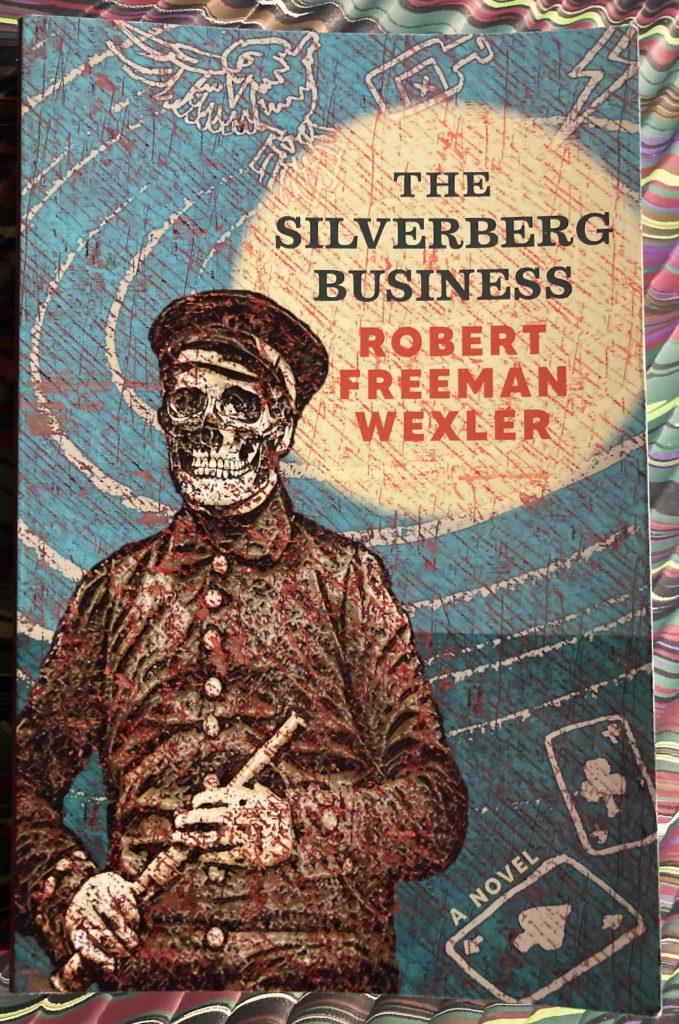
— Robert Freeman Wexler. The Silverberg Business. [vi], 269, [1, blank], [1, about the author], [5, blank], [4, ads]. Small Beer Press, [2022]. Wrappers with illustration by Jon Langford.
The Silverberg Business follows Shannon, a Jewish private detective who has come to Victoria, Texas, in late October 1888, in search of information about a missing man and the large bank draft he carried, representing funds raised on behalf of a Romanian Jewish refugee settlement plan. Shannon, a Galveston native with a talent for finding bodies, uncovers fraud and murder, and indications of concerted sinister activity in and around southern coastal Texas. We get a clear sense of the “feel of a frontier town” in Victoria, and the people living there. Shannon gets knocked over the head on several occasions. He works for a Chicago agency and has considerable autonomy. The detective talks, and listens to people from all walks of life, bankers and bank clerks, railroad conductors and bartenders, laundresses and rooming-house owners, marshals and horse dealers, gamblers, whores, and rabbis. In the course of his narration, Shannon drops elements of his own history and character. His tenacity of purpose leads him into strange places, and the reader goes with him, out into sparsely populated terrain, and elsewhere.
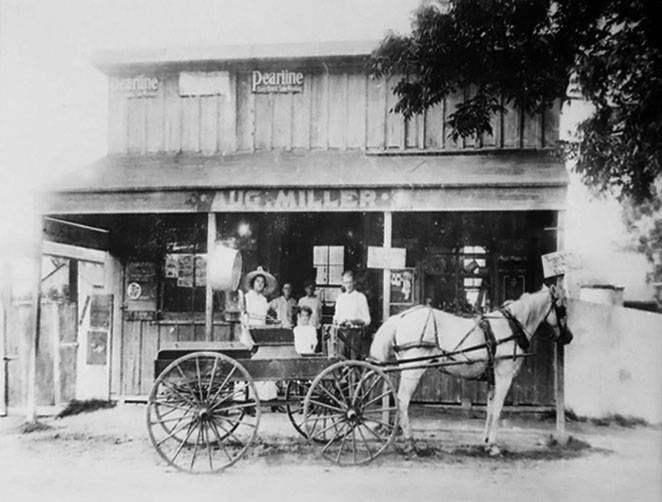
Shannon’s first-person narrative voice is matter-of-fact, smart and aphoristic, and keenly observant of his surroundings. He is Hammett’s Continental Op on the ground in 1880s Texas, which would be interesting enough, but Wexler also reappropriates the Western as a literary domain, and goes farther even than William S. Burroughs did in The Place of Dead Roads. Wexler’s achievement is to have created a formally innovative fiction that moves seamlessly, and beautifully, from dream to waking to sensory hallucination and then back to the mug of coffee the waitress has set before Shannon in the dining room at the Delmonico Hotel. He soon discovers that Silverberg, an Easterner, was seen in the company of a well-dressed Westerner with bad teeth and a gambler named Stephens. A conductor describes Stephens: “whitish hair, somewhat taller than average, red-brown eyes, a tendency toward fancy dress.”
Shannon muses:
Was Stephens the man who walked past the hotel restaurant and stared in at me? White . . . blond . . . storm of white-capped waves gouged the coast . . . an oak that had stood for centuries screamed and gave up its life . . . nothing remained, nothing but naked earth twisted into shapes of the dead and dying. I cried for the land, but what use are tears?
Stephens wears an onyx ring with a Greek god carved into it, and demonstrates a capacity to come and go as he pleases. There is often a stench of sea rot as the mark of his passage.
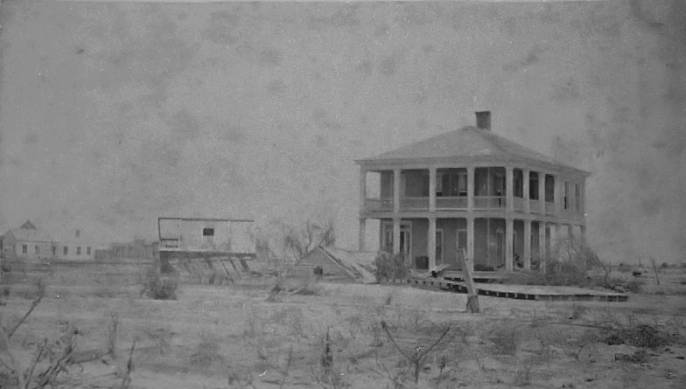
Pursuing the gambler, Shannon saddles up his horse, Blue Swamp, and rides out of Port Lavaca towards the ruined town of Indianola, which had been flattened by an earlier hurricane. He spends a couple of nights camping, fishing and shooting ducks for his meals, befriending a one-winged bald eagle, and has strange dreams. The next day as he gets near Matagorda Bay, the noon sky turns dark. “Reddish light washed the salt-cedars and cactus.” When his Blue Swamp refuses to move further, Shannon goes ahead on foot and finds an unexpected sand hill on the barrier island.
Sand hills form, blow apart, re-form, eventually becoming immobilized by growth of sea oats, goateed, and other plants. This one was crusty, bare, more like sandstone than sand, and the front looked sculpted, carved into features . . . curl of lip, open mouth, deep eye holes. A rotting animal festered in the mouth.
Then I found the body.
It is the murdered Silverberg. When the weather turns inclement, Shannon passes the night at the farm of Ratface Conroy. Out in the tumble-down barn, “a lean-to strung together from broken parts of other structures,” Shannon’s sleep is interrupted when his hosts attempt to murder him. Shannon shoots the husband and goes after Mrs. Conroy, who is armed. Pushing through a curtain in the sod farmhouse, Shannon enters a giant, ruined stone mansion. He shoots her dead, and returns to find a zombie “skull-head” Conroy armed and awaiting him. Shannon is faster at the draw, and sets the house ablaze as he leaves. This is not the last of the skull-heads Shannon will encounter.
— — —
Though I wasn’t playing poker, the same rules applied — watch, wait, calculate the odds.
There’s a lot of poker in The Silverberg Business, stud poker where only the first card is dealt face down to each player, and all the other cards are visible upon the table as they fall. This is emblematic of Wexler’s narrative method, for the reader sees what Shannon sees, and patterns are deduced from evidence visible and from inferences about what remains concealed.
Time is a hill, a hill that grows as you climb, grows to mountainside. Wind and rain alter the mountain, exposing rock, minerals. Looking back the way you came gets harder. Sometimes, all you can see is the rising path ahead of you. You get to the top. Everybody does. Sometimes sooner than we expect. The journey is what matters. Here in skull-head land, time means nothing.
These fugues and hallucinations and strange dreams are integral to the way Shannon gains knowledge of the strange world he enters. And the reader enters with him, for his voice is supple enough to take in this space outside of time, poker-playing zombies, and a daring escape in the Flying Kestrel, a contraption from the Sonora Aero Club, across a landscape of perpetual intertemporal war. Abandoned in a Louisiana swamp by the pilot of the Kestrel, he finds that months have passed.
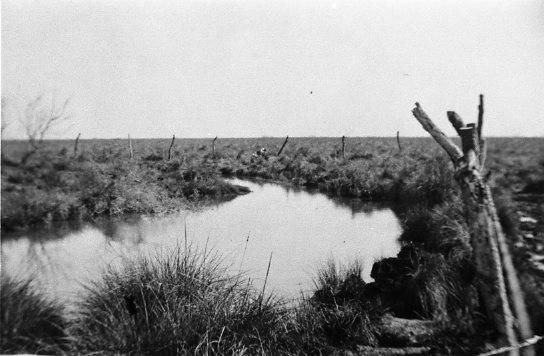
The measure of Shannon’s persistence is seen in the way he makes his return to Victoria and resumes his investigation of the gambler, no matter the cost. Among further clues are strange manuscript account in Spanish recording the indigenous culture of the region, and a pattern of inexplicable land purchases on barrier islands. On a visit to the prison in Huntsville. Shannon finds the prisoner he expected to interview has been murdered. Chasing Stephens down a stairway that couldn’t exist, Shannon finds himself again in the land of the skull-heads, and the poker-playing begins in earnest. The stakes couldn’t be higher.
— — —
In a review of an exhibition of paintings by J. M. W. Turner, critic Jackie Wullschläger usefully articulates the notion that Turner’s work began to push “beyond realistic description”. As readers and writers, all we have are words, but sometimes that is sufficient. The Silverberg Business is a book that demonstrates what fiction is all about.
Continuity is a convenient illusion. The discontinuities of Shannon’s subjective experience — dream, beautiful maritime interludes, fugue states, hallucination, or return to consciousness after getting clobbered on the head — are as cut-up as anything from Burroughs, and the psychological and geographical terrain of the novel are vast spaces, but Shannon is unflappable, no matter how weird it gets. The Silverberg Business is linear and direct in its narrative line even as the words dance across time and space from sentence to sentence within a single paragraph.
I wasn’t sure I would be able to function . . . I . . . Stephens, looming gigantic , his red eyes roasted my flesh. Shriveled strips floated on the waves, adhered to the sides of the boat, and the ocean, all its weight above, squeezing me into nothingness. I swam into a cave, a cavern so vast it held the world, and beyond, the sparkling Mediterranean of Salonica’s harbor. Captain Bellis gave the order “Moor ship!” and our boat thumped into the remnants of a Galveston pier.
Wexler’s prose is shocking, funny, and vivid, and can go anywhere, and he goes to some very strange places (the summary above leaves off about halfway through the book, so buy the book and read it).
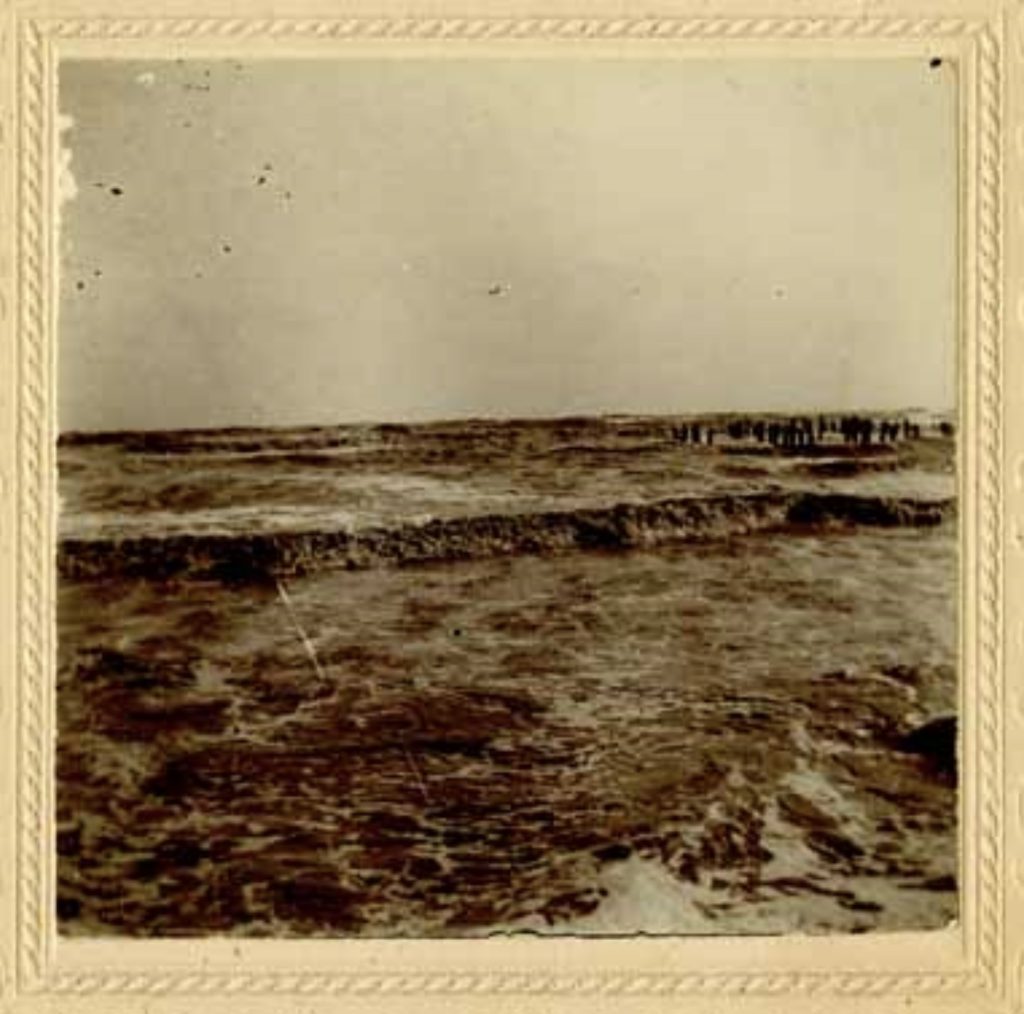
In The Silverberg Business, there are also countless playful allusions to elements of American literature high and low, among them Winsor McCay’s Little Nemo; Dashiell Hammett and William S. Burroughs, as noted earlier; and, though his name is nowhere mentioned, H. P. Lovecraft, especially in the sense of menace and the notion that human actors would be serving malign powers and non-human entities. The Silverberg Business is also a notable evocation of Jewish life in late-nineteenth century Texas. Wexler’s narrator unifies all these many fissiparous elements, and the concluding passages are tragic, deeply earned, and very moving. An outstanding work, the best book I’ve read this year.
The Endless Bookshelf book of the year 2022.
‘merging, not with the car, but with the road’
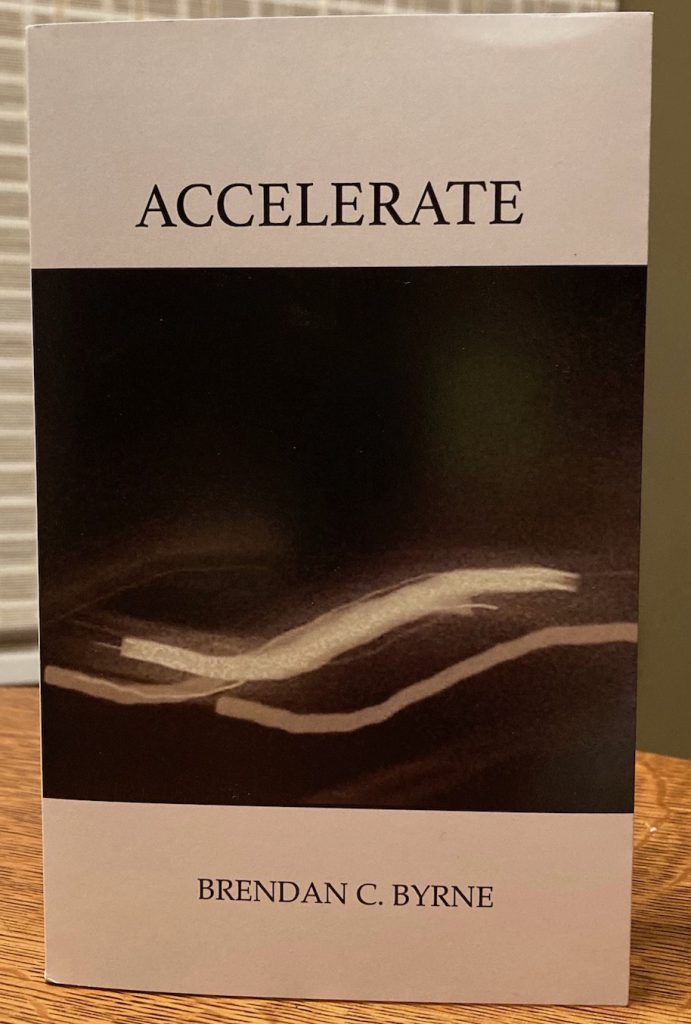
— Brendan C. Byrne. Accelerate. 96 pp. Small 8vo, [Moonachie, New Jersey], 2022 [i.e., 3 November 2021]. Pictorial wrappers, dust jacket with french flaps. From a small edition printed for the author just before the publication of the e-booke by Neotext. The title page verso reads Copyright 2020.
This is a remarkable book. In a future Los Angeles, couriers caged with their autonomous vehicles pound nutritional “sluice” and make deliveries at 198 m.p.h. Joam has refused to let the hardware make all his driving decisions yet lives almost integrated within his armored “beater”. He receives a commission to deliver a packet to New York within 72 hours. The narrative is all attitude and the lingo is a brilliant street jargon, an immersive account of Joam hurtling across the landscape of American political collapse, seeing off jealous rivals. Some of Byrne’s earlier work, such as “a Stone and a Cloud”, seems to chart the erosion of humanity in the technological future. Accelerate is a gonzo cross-country road-trip — west to east — which tells a moving story of personal loss as, paradoxically, the machine becomes human. The best book of the year 2021.
‘slipping in between’
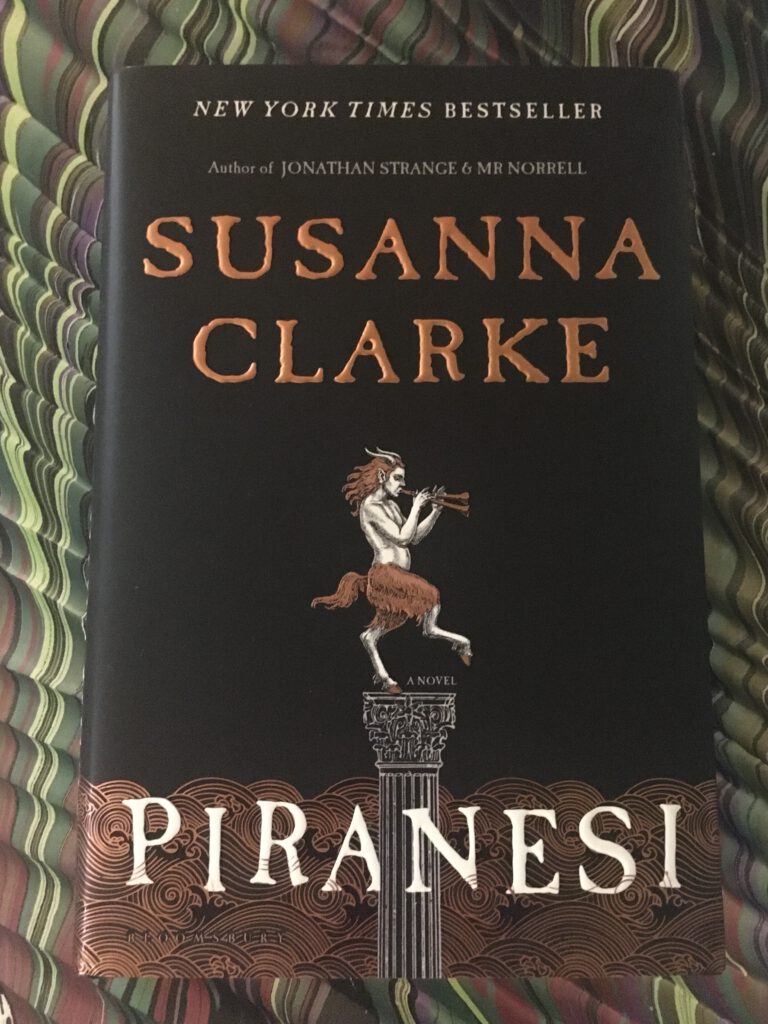
— Susanna Clarke. Piranesi. Bloomsbury, [2020]. The best book of the year (though I came late to the party). A compelling and richly visual labyrinth, a world entire created within this beautiful story, and then there is a plot : the apparent madness of the central character (dubbed Piranesi with the knowing, exquisite cruelty of his enchanter) is resolved partly through the persistence of an investigating officer but chiefly though the prodigious remembering of Piranesi.
Piranesi made this reader think, ah, here is the tale of the subjective experience of one of those characters who are nothing but roadkill in The Secret History or The Magicians. And in charting this terrain, Clarke challenges the assumptions of the heedless, privileged seekers who in other novels inflict suffering upon others without consequence.
This book is like no other, and yet the succession of detailed tableaux, and the trajectory of healing in Piranesi, both made me think of The Secret Service by Wendy Walker, in particular Chapter Nine, the account of Polly’s travels while she is a broken goblet, which almost forms a novel within the novel. Piranesi’s engravings of ruins and prisons are nowhere explicitly cited in this novel, but in the early pages I did have a feeling of now I know, the residents of The Library of Babel are all mad, and Piranesi’s landscapes of the imagination are plates to Borges’ story (file under : Borges and his predecessors). Three other tales of madness and movement through strange landscapes sprang to mind, the ascent in Lovecraft’s “The Outsider”, Gene Wolfe’s variations on Doctor Island, and Doris Lessing’s Briefing for a Descent into Hell. Piranesi is almost entirely unlike any of them.
The unconditional goodness of the central character shines everywhere in this book (John Clute called my attention to this in conversation, and he has written of the “radiantly good ‘Piranesi’” here ). The book has been widely praised and reviewed, as I said, I came late to the book, but it was the best book of 2020.
[I am deeply grateful to GS who alerted me to this book.]